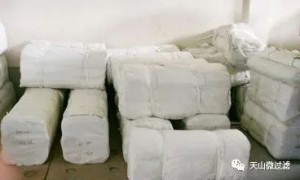With the rapid development of industrialization, environmental pollution caused by industrial production is becoming more and more serious. It is an effective way to filter liquid and gas in industrial production by using textile filter material. Polypropylene woven press cloth has high strength, acid and alkali resistance, pollution and antibacterial, good dimensional stability and other excellent properties, has become one of the main filter materials in pharmaceutical, food, chemical and other industries.
(1) polypropylene filament performance evaluation
The surface morphology, contact Angle, DSC, dry heat shrinkage and tensile fracture properties of 93tex polypropylene filament were tested. In terms of surface morphology, the longitudinal surface of pp filament is smooth. The contact Angle of polypropylene filament is 110° and the melting point is 158.53℃. The dry heat shrinkage rate of pp filament at 80℃, 100℃, 120℃ and 140℃ was tested. It was found that the dry heat shrinkage rate of PP filament increases gradually with the increase of temperature, and the shrinkage rate of PP filament increases from 0.65% to 23.60% without tension, and from 0.10% to 3.55% under certain tension. The breaking strength of pp filament is more than 58 cN/ Tex, and the strength and elongation performance is better.
(2) preparation of polypropylene woven press cloth
2/2 twill press cloth is woven on dorier rapier loom with 93tex, 120 twist /m polypropylene filament as warp yarn, 93tex, 0 twist /m polypropylene filament as weft yarn, using 299×118, 268×118, 236×118, 236×130, 236×102. Finally, 15 kinds of polypropylene woven press fabrics were prepared. The structural parameters such as warp and weft density, gram weight and thickness of the press fabrics were tested.

(3) The effect of finishing on the properties of polypropylene woven press cloth
The influence of finishing on the properties of polypropylene woven press cloth was evaluated by testing the surface morphology, pore size, permeability and tensile fracture strength of the three kinds of press cloth samples. The results show that compared with the press cloth without finishing, the surface of the press cloth after finishing is smooth, the structure is compact, and the fibers in the press cloth after setting and calendering appear partial melting. After finishing, the pore diameter and permeability of the press cloth decreased, and the average pore diameter decreased by about 50%, while the decrease of permeability fluctuated greatly. The strength of the press cloth increased by 27.53% after finishing, while the strength of the press cloth did not change significantly after finishing.
(4) Thermal performance evaluation of polypropylene woven press cloth
The thermal properties of polypropylene woven press cloth were evaluated by measuring DSC curve, dry heat shrinkage rate and mechanical property retention rate of press cloth before and after dry heat treatment. The results show that the melting point of pp woven press cloth with different temperature is in the range of 157~159℃, and the fluctuation is relatively small. The dry heat shrinkage rate of press cloth increases with the increase of dry heat treatment temperature, and the shrinkage rate can increase from 3.67% to 21.33%. After dry heat treatment at 120℃, the air permeability of polypropylene woven press cloth decreases the most. When the dry heat treatment temperature exceeds 120℃, the strength retention rate of polypropylene woven press cloth is below 80%.
Post time: Jul-05-2022



